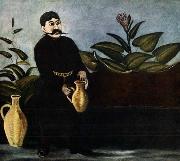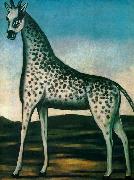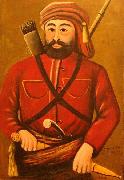Niko Pirosmanashvili Olja Måleriet ReproduceringAll Niko Pirosmanashvili Oil Paintings(born Niko Pirosmanashvili; May 5, 1862-1918) was a Georgian primitivist painter. Pirosmani was born in the Georgian village of Mirzaani to a pleasant family in the Kakheti province. His family owned a small vineyard. He was later orphaned and put in the care of his two elder sisters. He moved with them to Tbilisi in 1870. In 1872 he worked as a servant for wealthy families and learned to read and write Russian and Georgian. In 1876 he returned to Mirzaani and worked as a herdsman. Pirosmani gradually taught himself to paint. One of his specialties was painting directly into black oilcloth. In 1882 he opened a workshop in Tbilisi which was unsuccessful. In 1890 he worked as a railroad conductor, and in 1895 worked creating signboards. In 1893 he co-founded a dairy farm in Tbilisi which he left in 1901. Throughout his life Pirosmani, who was always poor, was willing to take up ordinary jobs including housepainting and whitewashing buildings. Although his paintings had some local popularity (about 200 survive) his relationship with professional artists remained uneasy; making a living was always more important to him than abstract aesthetics. |
|||

|
|||
|
|
|||
|
||||||||
| Niko Pirosmanashvili (born Niko Pirosmanashvili; May 5, 1862-1918) was a Georgian primitivist painter. Pirosmani was born in the Georgian village of Mirzaani to a pleasant family in the Kakheti province. His family owned a small vineyard. He was later orphaned and put in the care of his two elder sisters. He moved with them to Tbilisi in 1870. In 1872 he worked as a servant for wealthy families and learned to read and write Russian and Georgian. In 1876 he returned to Mirzaani and worked as a herdsman. Pirosmani gradually taught himself to paint. One of his specialties was painting directly into black oilcloth. In 1882 he opened a workshop in Tbilisi which was unsuccessful. In 1890 he worked as a railroad conductor, and in 1895 worked creating signboards. In 1893 he co-founded a dairy farm in Tbilisi which he left in 1901. Throughout his life Pirosmani, who was always poor, was willing to take up ordinary jobs including housepainting and whitewashing buildings. Although his paintings had some local popularity (about 200 survive) his relationship with professional artists remained uneasy; making a living was always more important to him than abstract aesthetics. |
||||||||
|
|
||||||||
| Måleriet Identifieringen :: 96647 Sarkis Pouring Wine Oil on oil-cloth, 92x101 cm pre 1919 cjr |
||||||||
|
|
||||||||
| Måleriet Identifieringen :: 96681 Giraffe 1900s Medium Oil painting on oilcloth Dimensions 112 X 138 cm (44.1 X 54.3 in) cjr |
||||||||
|
|
||||||||
| Måleriet Identifieringen :: 96757 Giorgi Saakadze 1913(1913) cjr |
||||||||
|
|
||||||||
| FÖREGÅENDE KONSTNÄR Nästa Konstnär | ||||||||
|
|
||||||||
|
Niko Pirosmanashvili (born Niko Pirosmanashvili; May 5, 1862-1918) was a Georgian primitivist painter. Pirosmani was born in the Georgian village of Mirzaani to a pleasant family in the Kakheti province. His family owned a small vineyard. He was later orphaned and put in the care of his two elder sisters. He moved with them to Tbilisi in 1870. In 1872 he worked as a servant for wealthy families and learned to read and write Russian and Georgian. In 1876 he returned to Mirzaani and worked as a herdsman. Pirosmani gradually taught himself to paint. One of his specialties was painting directly into black oilcloth. In 1882 he opened a workshop in Tbilisi which was unsuccessful. In 1890 he worked as a railroad conductor, and in 1895 worked creating signboards. In 1893 he co-founded a dairy farm in Tbilisi which he left in 1901. Throughout his life Pirosmani, who was always poor, was willing to take up ordinary jobs including housepainting and whitewashing buildings. Although his paintings had some local popularity (about 200 survive) his relationship with professional artists remained uneasy; making a living was always more important to him than abstract aesthetics. |
||||||||
|
|
||||||||
|
KOMMA I KONTAKT MED Oss |








